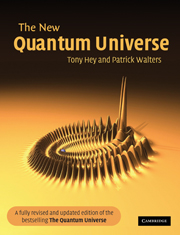Book contents
- Frontmatter
- Contents
- Preface
- Prologue
- Route map
- 1 Waves versus particles
- 2 Heisenberg and uncertainty
- 3 Schrödinger and matter waves
- 4 Atoms and nuclei
- 5 Quantum tunnelling
- 6 Pauli and the elements
- 7 Quantum co-operation and superfluids
- 8 Quantum jumps
- 9 Quantum engineering
- 10 Death of a star
- 11 Feynman rules
- 12 Weak photons and strong glue
- 13 Afterword – quantum physics and science fiction
- Epilogue
- Appendix 1 The size of things
- Appendix 2 Solving the Schrödinger equation
- Glossary
- Quotations and sources
- Suggestions for further reading
- Photo-credits
- Name index
- Subject index
6 - Pauli and the elements
Published online by Cambridge University Press: 05 October 2013
- Frontmatter
- Contents
- Preface
- Prologue
- Route map
- 1 Waves versus particles
- 2 Heisenberg and uncertainty
- 3 Schrödinger and matter waves
- 4 Atoms and nuclei
- 5 Quantum tunnelling
- 6 Pauli and the elements
- 7 Quantum co-operation and superfluids
- 8 Quantum jumps
- 9 Quantum engineering
- 10 Death of a star
- 11 Feynman rules
- 12 Weak photons and strong glue
- 13 Afterword – quantum physics and science fiction
- Epilogue
- Appendix 1 The size of things
- Appendix 2 Solving the Schrödinger equation
- Glossary
- Quotations and sources
- Suggestions for further reading
- Photo-credits
- Name index
- Subject index
Summary
It is the fact that the electrons cannot all get on top of each other that makes tables and everything else solid.
Richard FeynmanElectron spin and Pauli's exclusion principle
Over a century ago, a Russian chemist, Dimitri Mendeleev, invented a teaching-aid for students struggling with inorganic chemistry. He realized that the properties of the 63 elements then known were repeated ‘periodically’ as their atomic weight increased. In other words, elements with similar chemical properties were not close together in mass, but instead were found at regular intervals as the mass increased. For example, lithium has a nucleus with three protons and is an alkali metal – a highly reactive soft silvery substance that forms alkaline oxides and hydroxides. The next alkali metal is sodium with eleven protons, then potassium with nineteen, and so on, all with increasing mass. Mendeleev was able to group all the elements into distinct families, and his scheme became known as the ‘periodic table’ of the elements. All good theories should be able to make predictions and this was no exception. Because of the regularities he had observed, Mendeleev realized that his list of elements must be incomplete. He therefore left gaps in his table corresponding to as yet undiscovered elements, and had the satisfaction of seeing gallium, scandium and germanium discovered during his lifetime. Nevertheless, the explanation of these periodicities remained a mystery for over 50 years until the Austrian physicist Wolfgang Pauli put forward his famous ‘exclusion principle’.
- Type
- Chapter
- Information
- The New Quantum Universe , pp. 107 - 130Publisher: Cambridge University PressPrint publication year: 2003



